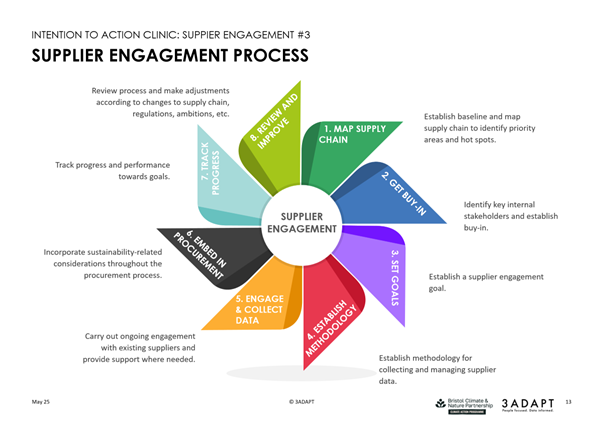Insights from 3ADAPT’s collaboration with the Bristol Climate & Nature Partnership
At 3ADAPT, we work with public, private and third sector organisations to decarbonise, adapt to climate change and manage their sustainability impacts. One of the most challenging areas that comes up time and time again is reducing impacts across an organisation’s supply chain. Typically, this is where the largest source of emissions are driven from, whilst also being the most challenging to tackle due to the nature of primarily being outside of an organisation’s direct control.
Following on from our introduction session on Supplier Engagement, we are once again diving into our 8-step process – the ‘Windmill of Change’ – to help drive sustainable procurement in organisations, addressing the common challenges of supplier engagement and data management along the way:
Our 8-step Supplier Engagement Process to drive sustainable procurement.
3ADAPT partnered with the Bristol Climate & Nature Partnership to run a series of sessions covering how supplier engagement can help organisations better understand and address supply chain impacts for organisations across Bristol. In collaboration, we developed a Supplier Engagement Guide, which summarises key findings from this process to support organisations wishing to tackle supply chain impacts.
Some of the most challenging steps in the process focused on stage 5 ‘Engaging Suppliers’, where attendees asked questions such as:
When and how should I engage suppliers?
How can we manage limited resources?
How do we manage supplier data?
How do we set and measure progress?
These questions shaped our most recent session, the Intention to Action Clinic: Supplier Engagement, which featured small breakout groups for attendees to share challenges and insights.
Sara Telehoun from 3ADAPT presenting at the Supplier Engagement session.
We expanded on step 5 of our Supplier Engagement Process, including guidance on:
How to engage suppliers effectively
Secure internal buy-in: engagement is most successful when it is supported, aligned with goals and strategy, and leveraged through strong internal collaboration.
Set clear goals and communicate expectations: define the purpose of the engagement (such as emissions reduction, social value), and clearly outline your sustainability expectations and targets to suppliers.
Prioritise and tailor your approach: not all suppliers will need the same level of engagement – focus efforts using ranking criteria such as emissions, spend, maturity, and influence.
Use diverse methods to build relationships: combine approaches such as surveys, interviews, training, webinars, and best practice sharing to support and collaborate with suppliers effectively.
How to support suppliers
Understand supplier readiness and barriers: assess current capabilities, challenges, and support needs.
Provide practical resources: share tools templates, and training to reduce operational burden and promote collaboration.
Standardise data collection: use consistent formats to ensure comparability and streamlined reporting.
Create feedback loops: offer ongoing support and space for suppliers to share progress or challenges.
Promote continuous improvement: encourage year-on-year progress rather than expecting perfection from the outset.
How to gather data
Use standardised templates: provide a simple, consistent spreadsheet or online form with clear fields (e.g., annual kWh, emissions by scope) and brief instructions or examples.
Offer practical guidance: share how-go guides outlining what data is needed, how to calculate it, and what to document such as assumptions, emission factors, and reporting periods.
Support with training: run interactive sessions (such as webinars) to walk through templates, answer questions, and provide accessible reference materials and channels.
Ask clear, structured questions: gather data on climate commitments, emissions tracking, targets, and strategies with prompts to understand the supplier.
How to manage data
Set clear data collection schedules and update frequencies: to keep information current and reliable.
Assign dedicated data owners and managers: to ensure accountability and data quality.
Implement a strategized data storage system: to enable easy comparison and integrate across suppliers.
Define clear guidelines for data use, reporting, and presentation: to support informed decision-making and supplier collaboration.
An important part of the supplier engagement process will be getting an undestanding of an important question upfront:
Setting your goal: a question to help you outline clear boundaries, aims, and objectives before engaging your suppliers.
A clear and defined answer to this question early in your sustainable procurement journey will enable your organisation to effectively communicate its needs and goals to stakeholders involved, eliminating any confusion and allowing drive towards a clear common goal. It is also important to understand supplier readiness, including any barriers they may have, and to also understand their needs.
In the breakout sessions, facilitated by 3ADAPT and Bristol Climate & Nature Partnership, organisations’ challenges were discussed and potential solutions to address these were discussed:
Challenge 1: Resource and capacity constraints
Assign dedicated roles or internal working groups
Use prioritisation (spend or emission size) to target stakeholders to engage
Collaborate with peers (e.g. local partnerships or industry groups) to share learnings, tools, templates
Challenge 2: Unclear goals and internal alignment
Define clear objectives
Build internal buy-in through case studies and engagement sessions
Challenge 3: Data visibility and access issues
Encourage transparency
Track methodology changes
Request accessible data from suppliers using simple, or their own, platforms
Support and incentivise suppliers, leaning on external established guidance and resources
Challenge 4: Fragmented procurement processes
Centralise procurement where possible
Improve internal communication channels
Train key internal stakeholders across departments
Challenge 5: Lack of clarity on who owns supplier relationships
Mapping out who owns supplier relationships internally
Running training and support sessions for contract managers
The sharing of common challenges and openly discussing these created a valuable space for peer learning and practical problem solving. The session feedback received demonstrated that organisations realised they were not alone, and accelerated progress through sharing insights, as well as driving a more aligned community of practice around sustainable procurement.
Summary
It was fantastic to be a part of this Sustainable Procurement series in collaboration with the Bristol Climate & Nature Partnership. Our experience with the sessions saw multiple organisations across a vast range of sectors keen to learn from others about supplier engagement practices, and we thank you for your enthusiasm and also openness to share personal challenges with others. We hope that attendees left with some practical solutions and a new-found lease of determination to tackle the complex challenge that is supply chain emissions.
Missed Part 1? Catch up on the first post in this series here.
Get in touch
At 3ADAPT, no matter how far, or early, you are along your supplier engagement process, we are here to support. Whether you are looking to refine your supplier engagement strategy, gain support engaging with suppliers or collecting data, set actionable goals, or navigate the complexities of sustainability reporting, our team is here to help.







